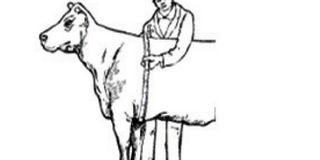YOUR ANIMAL DOCTOR

How to measure the weight of a cow without a weighing scale by using a weighing band. ILLUSTRATION | COURTESY
What you need to know:
- The weight of a cow may be measured using a weighing band.
- Blood meal may not go beyond 35 to 40 per cent, best at 20 per cent.
- Egg production is a factor of the genetics of the birds, nutrition and the environment.
- The size of a poultry house depends on the number of birds one intends to keep.
Getting cow weight without a scale
How do I measure the weight of my cow without a weighing scale for the purpose of deworming it? I am told there is a simple method.
Maurice
The weight of a cow may be measured using a weighing band. When taking measurements, place the weigh band behind the front legs at the level of the elbows then take it all the way round to a point behind the shoulder blades of the cow.
Pull it tightly and read the measurements directly on the tape. Weigh bands are available in agrovets.
***
Protein ratio in poultry feeds
I want to make animal feeds to sell in the market and we would like to know the recommended ratio of animal to plant protein in poultry feeds. That is, fishmeal, blood meal, bone meal and hydrolised feather meal.
Odhiambo
It doesn’t really matter whether you use animal or plant proteins provided your feed has sufficient proteins. Your fish meal must not exceed 9 per cent or else the eggs/meat will have a ‘fishy’ smell.
Blood meal may not go beyond 35 to 40 per cent, best at 20 per cent. Feathers are a good source of protein but must be processed properly.
***
Cause of low egg production
I am a poultry farmer with 150 Rainbow Rooster birds that gave me my first egg on October 7, 2017 exactly five months from the day l received one-day old chicks. Production went on consistently until it reached 81 per cent, that is four trays (120 eggs) on November 16 when they engaged the reverse gear. I currently collect between 45 and 60 eggs which makes no economic sense to continue with the agribusiness. I feed them on Kienyeji layers mash.
Nick Siko Nyandoro, Mombasa
I have no reason to believe that the birds are sick, as you would have mentioned that if they were. The 50 per cent drop in egg production after only five weeks in lay, when they ought to have been picking, is a pointer to some fairly serious happening.
Egg production is a factor of the genetics of the birds, nutrition and the environment. My take is there is something to do with the feeds/feeding, water or changes in the birds’ immediate environment. These would include:
- Change in weather conditions, like if it gets hotter.
- Vaccination and/or de-beaking during laying.
- Feed rationing.
- Change in feed quality. Note that it is possible for batches of feed from the same miller to be different and birds can pick that.
- Insufficient fresh drinking water.
- Exposure to shorter photo - period hours of light.
- Egg pecking/eating.
- Infestations with internal or external parasites.
- Egg-eating by predators, or even a cat.
- Other disturbances.
Try to establish which among these may have contributed to the drop, correct it and offer them Stimosol and Stressmix for faster recovery. If unable to get to the bottom of it, you may call me directly.
***
Getting it right on poultry house
I keep chickens for subsistence but I would now like to upgrade to commercial poultry farming. Can I build the house myself?
Kigen
The size of a poultry house depends on the number of birds one intends to keep. Ordinarily, each layer bird will require 2 square ft while a broiler bird 1 square ft.
You can build the house yourself or get help from a carpenter. (Check design on Seeds of Gold December 9, 2017 issue for a poultry unit that can house up to 500 layers/1,000 broiler birds. It is also available online.
****
Dr John Muchibi is a Veterinary Surgeon and the Animal Health Manager at Elgon Kenya Ltd. Reach him through +254733715102 or e-mail him through [email protected]





